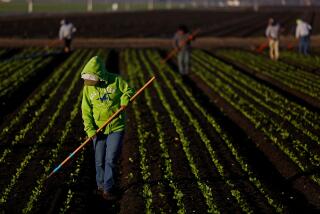Trade Accord Could Mean Growing Pains for Farmers : GATT: U.S. and French tillers are fellows of the field, but differences in philosophy are at the root of a dispute.
- Share via
ST. GERMAIN-LE-GAILLARD, France — Antoine Lecuyer and John Stegman have no quarrel with one another.
Lecuyer, a barrel-gutted, bushy-haired wheat grower from this ancient village southwest of Paris, wants the same things from life as Stegman, his spare and weathered counterpart from the high plains of western Kansas: a decent crop, a fair price, an independent existence and the respect of their countrymen.
They are fellows of the field, their lives regulated by the rhythms of sun, wind and rain, trying to coax a harvest of winter wheat from the ground and a profitable price from the granary.
But their lives and their livelihoods are the source of intense dispute between their governments as a global series of talks under the auspices of the General Agreement on Tariffs and Trade (GATT) reaches its climax.
Even if an accord is reached in the next few days on the broad trade agenda under GATT, dramatic differences will remain between the French and American way of farming. And the agreement will still allow considerable latitude to member governments to continue extensive support for their farmers.
Agricultural producers in France and in the United States receive production subsidies and other aid from their governments, although the level of payments and the philosophy behind them differ markedly.
Washington supports agriculture chiefly as a means of achieving a rough parity between supply and demand; the French system is designed not only to bolster production but to sustain a way of life that is deeply embedded in the national psyche, a romantic vision of rural life as the wellspring of all things truly French.
The costly French subsidy program also aims to keep farmers on the land to discourage them from moving to the towns and cities and adding to the nation’s severe unemployment. There is also a desire to maintain a lively, well-kept rural France as a vacation paradise for the urban middle and upper classes, as well as foreign tourists.
Thus, Stegman farms more than 2,000 acres with advanced technology and a relative minimum of government assistance, while Lecuyer’s labor-intensive 450-acre farm is accorded considerably higher public subsidies.
But the 32-year-old Frenchman fears that all that will change if negotiators now laboring to conclude the GATT talks succeed in refashioning the French way of farming to bring it more in line with world standards. He worries that his farm, along with the rundown, 22-room castle, the moss-topped chicken barns and, eventually, the way of life that the French hold dear, may disappear forever.
“For 15 years now, we’ve made a big effort to adapt,” Lecuyer says. “I’ve added chickens to the farm. I’ve started renting out part of my house to vacationers. But I can’t find any more solutions. If the politicians tell me I have to work more to get the same, I say it’s not possible.”
For his part, Stegman, 56, has few fears about the future. His home, land and equipment are paid for and his 34-year-old son is poised to take over the family operation when he retires.
On his vast fields near the town of Spearville in western Kansas, where the terrain is as flat and featureless as the sea, Stegman plants about 1,000 acres of hard red winter wheat each September and harvests more than 30,000 bushels of grain each June. He has two large modern tractors and a small fleet of auxiliary equipment to turn the land, plant the seed, fertilize the soil, harvest the crop and deliver the grain to the elevator.
His chief form of government support comes in “deficiency payments” from the Department of Agriculture, which makes up the difference between the price he receives from his marketing cooperative and a target price set each year by the federal government. The payment this year was about 50 cents a bushel and is based on a variety of factors, including the number of acres left fallow and nationwide grain production.
He follows the U.S.-European agricultural dispute through the local chapter of the American Farm Bureau Federation and from the computer terminal in the study of his 100-year-old farmhouse.
He empathizes with his French counterpart, saying he is the beneficiary of policies that have their root in the dark days of World War II, when much of Europe faced starvation.
“These people, not only in France, but everywhere in Europe, they went awfully hungry during the war, and those responsible for setting agricultural policy remember that,” Stegman said.
But Stegman also expressed mild resentment of European governments for their high level of support for farmers, although he doesn’t believe it has affected the price or market for his own crop. His wheat is sold to a local cooperative and then shipped to Kansas City for milling. As far as he knows, it is all consumed within the United States as bread or breakfast cereal.
Paul Drazek, an economist at the American Farm Bureau, estimated that the United States, with a population of 250 million, contributes $17 billion a year in direct and indirect subsidies to American farmers. The 12 nations of the European Community, encompassing 354 million people, spend approximately $80 billion in farm support, Drazek said.
That’s small comfort to Lecuyer and other small European producers.
A huge surplus of food already has forced Europe to cut agricultural subsidies this year and to order farmers to leave 15% of their acreage fallow. More cuts are planned for the next two years, with or without a trade agreement.
But French farmers, who produce half of Europe’s farm products, complain that the payments they receive for their unseeded acres cover only half their fixed costs, meaning they lose money on every acre kept out of production.
Now, under the agriculture agreement reached a year ago, European farmers would see their subsidies cut and even more of their land ordered out of production. For many small French farmers, that will be the difference between breaking even and losing money.
Lecuyer’s operation, near St. Germain-le-Gaillard, a village of 200 people about 70 miles southwest of Paris, is a case in point. Sitting in his home office, equipped with a computer, fax machine and photocopier, Lecuyer outlines his problem.
He figures it costs him $370 an acre to maintain his farm. This year, the European Community reimbursed him about half that for the fields it ordered him to keep fallow.
He was able to recover those losses with his wheat and barley crop, which came in at about 115 bushels an acre, about average for the region. Each of those bushels brought Lecuyer $3.55 at the market and an additional $1 in subsidy from the EC. The resulting profit, about $100 an acre, was erased completely by his losses on the unused land.
Lecuyer, helplessly watching the developments in Brussels and Geneva, where negotiators from 112 nations are trying to wrap up the ambitious Uruguay Round of GATT, worries that the future prospects are no better.
“I don’t want these big farms here,” he said. “I want a village. I want people around me. If Brussels (the EC headquarters) tells me to leave more land fallow, I can’t do it. We’ll lose too much money and I won’t be able to go on.”
France’s farmers have been labeled as a major obstacles to a world farm accord, with some justification. Economists say France will benefit greatly from the boom in world trade expected if a GATT accord is signed. But farmers rightly believe that the accord will probably hurt them.
Although they account for just 2% of the country’s population, farmers are a potent political force.
Nearly 80% of the people living in France’s cities consider their roots to be in the countryside. And they share the farmers’ disdain for the growing power of America on the world stage. Polls indicate that France’s city dwellers have supported the French farmer’s plight, even when farmer protests have blockaded major thoroughfares and inconvenienced city populations.
Lecuyer, like many other small farmers in France, sees GATT as a way to give American farmers access to Europe without boosting French exports. He points out that French farmers face problems their American counterparts, who receive indirect government subsidies, do not.
Lecuyer lives in a modest-size castle, complete with an encircling moat, which was built before the French Revolution of 1789. He keeps his sole tractor, stocks of harvested wheat and several thousand chickens in a narrow steepled barn, built by his ancestors in 1850.
“If I only thought about economics,” he said, “I would tear this all down and build a modern, new building. But my great-great-great-grandfather would turn in his grave.”
While few American farmers have to worry about maintaining moats and turrets, some of Lecuyer’s other problems are no doubt familiar to his American counterparts, especially those squeezed off their family farms in the 1970s and early 1980s by falling land values and high-interest loans.
He has managed to hang on to a profit margin until now by boosting his yield, trying new crops and opening part of his home as a rented guest house. He also shares equipment with other farmers.
His efforts have helped him keep his head above water, while the number of farms around St. Germain-le-Gaillard has dwindled from 12 to five. But he’s unsure how long he’ll be able to survive.
Lecuyer has no beef with his American counterparts. “Some say this is the American farmer against the French farmer,” he said. “But it’s not true.
“I think the American farmers think like we do,” he added. “I’ve read where they say the same things we do.
”. . . Food is subsidized by governments everywhere, just so the taxpayers don’t have to pay the real prices at the market. I think we should join all farmers in the world and cut a deal,” he said.
More to Read
Sign up for Essential California
The most important California stories and recommendations in your inbox every morning.
You may occasionally receive promotional content from the Los Angeles Times.











